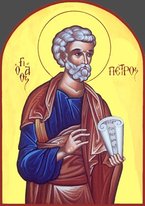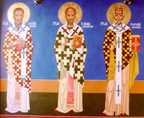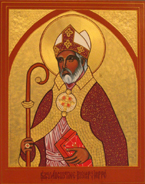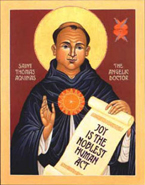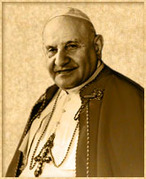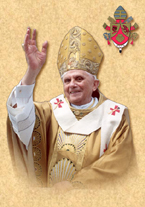The singing of the Church comes ultimately out of love. It is the utter depth of love that produces the singing. “Cantare amantis est”, says St Augustine, singing is a lover’s thing. In so saying, we come again to the trinitarian interpretation of Church music. The Holy Spirit is love, and it is he who produces the singing. He is the Spirit of Christ, the Spirit who draws us into love for Christ and so leads to the Father.
0 Comments
The importance of music in biblical religion is shown very simply by the fact that the verb “to sing” (with related words such as “song”, and. so forth) is one of the most commonly used words in the Bible. It occurs 309 times in the Old Testament and thirty-six in the New. When man comes into contact with God, mere speech is not enough. Areas of his existence are awakened that spontaneously turn into song. Indeed, man’s own being is insufficient for what he has to express, and so he invites the whole of creation to become a song with him: “Awake, my soul! Awake, 0 harp and lyre! I will awake the dawn! I will give thanks to you, 0 Lord, among the peoples; I will sing praises to you among the nations. For your steadfast love is great to the heavens, your faithfulness to the clouds” (Ps 57:8f.). We find the first mention of singing in the Bible after the crossing of the Red Sea. Israel has now been definitively delivered from slavery. In a desperate situation, it has had an overwhelming experience of God’s saving power. Just as Moses as a baby was taken from the Nile and only then really received the gift of life, so Israel now feels as if it has been, so to speak, taken out of the water: it is free, newly endowed with the gift of itself from God’s own hands. In the biblical account, the people’s reaction to the foundational event of salvation is described in this sentence: “[T]hey believed in the Lord and in his servant Moses” (Ex 14:31). But then follows a second reaction, which soars up from the first with elemental force: "Then Moses and the people of Israel sang this song to the Lord” (i 5: i). Year by year, at the Easter Vigil, Christians join in the singing of this song. They sing it in a new way as their song, because they know that they have been “taken out of the water” by God’s power, set free by God for authentic life. The greatness of the liturgy depends - we shall have to repeat this frequently - on its unspontaneity (Unbeliebigkeit)…. Only respect for the liturgy’s fundamental unspontaneity and pre-existing identity can give us what we hope for: the feast in which the great reality comes to us that we ourselves do not manufacture but receive as a gift. This means that “creativity” cannot be an authentic category for matters liturgical. In any case, this is a word that developed within the Marxist world view. Creativity means that in a universe that in itself is meaningless and came into existence through blind evolution, man can creatively fashion a new and better world. Modern theories of art think in terms of a nihilistic kind of creativity. Art is not meant to copy anything. Artistic creativity is under the free mastery of man, without being bound by norms or goals and subject to no questions of meaning. It may be that in such visions a cry for freedom is to be heard, a cry that in a world totally in the control of technology becomes a cry for help. Seen in this way, art appears as the final refuge of freedom. True, art has something to do with freedom, but freedom understood in the way we have been describing is empty. It is not redemptive, but makes despair sound like the last word of human existence. This kind of creativity has no place within the liturgy. The life of the liturgy does not come from what dawns upon the minds of individuals and planning groups. On the contrary, it is God’s descent upon our world, the source of real liberation. He alone can open the door to freedom. The more priests and faithful humbly surrender themselves to this descent of God, the more “new” the liturgy will constantly be, and the more true and personal it becomes. Yes, the liturgy becomes personal, true, and new, not through tomfoolery and banal experiments with the words, but through a courageous entry into the great reality that through the rite is always ahead of us and can never quite be overtaken. [ The Christian faith can never be separated from the soil of sacred events, from the choice made by God, who wanted to speak to us, to become man, to die and rise again, in a particular place and at a particular time. “Always” can only come from “once for all”. The Church does not pray in some kind of mythical omnitemporality. She cannot forsake her roots. She recognizes the true utterance of God precisely in the concreteness of its history, in time and place: to these God ties us, and by these we are all tied together. The diachronic aspect, praying with the Fathers and the apostles, is part of what we mean by rite, but it also includes a local aspect, extending from Jerusalem to Antioch, Rome, Alexandria, and Constantinople. Rites are not, therefore, just the products of inculturation, however much they may have incorporated elements from different cultures. They are forms of the apostolic Tradition and of its unfolding in the great places of the Tradition. I will not be starting an original series on the liturgy here. When it comes to discussions on liturgy, many people - both adherents and dissenters alike - are rather adamant about hearing from the "horse's mouth". Even simple statements like "This is just common sense" somehow won't do.
|
Categories
All
Archives
December 2021
|
|
FOLLOW DEACON SHERMAN DEACON'S FORMATION FB GROUP
© 2021 Sherman Kuek. All rights reserved.
|

 RSS Feed
RSS Feed
